You may know Croatia for its mezmorising turquoise waters or the medieval walled city of Dubrovnik where The Game of Thrones was filmed. What you may not know is just how tantalizing Croatian food is for your tastebuds. From simple grilled seafood, to tempting pastries, all the way to an ominous black dish that will make you double take, Croatia will have you unbuttoning your trousers to allow for some extra room to try just one more plate….or two.

Eat your way across Croatia with these 6 traditional dishes
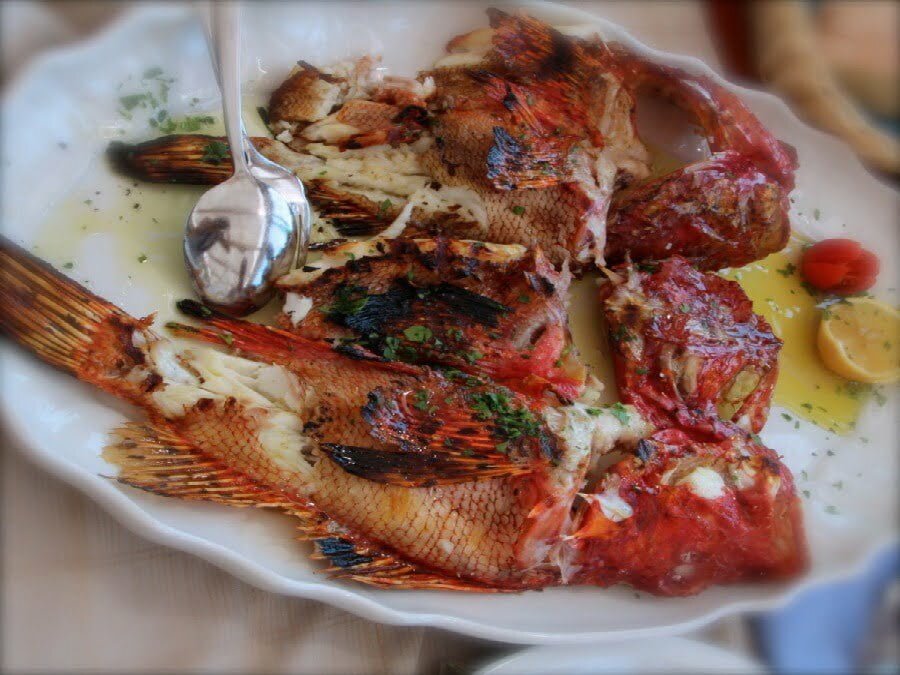
Pick up your knife, fork and spoon and let’s take the foodie tour of Croatia.

1) Kremšnite
Travelling to the northern parts of Croatia are a must for those with a sweet tooth. Head to the patisserie for the wiggly-wobbly dish of kremšnite. It will jiggle on your plate like a bobble head dog on a dashboard – but not for long. One bite into your kremšnite and you’ll be scooping the sweetened creamy custard filled centre, along with the crispy pastry, into your mouth in record time.
This vanilla and egg custard cream cake has several variations depending on which area of Croatia you are in. They all include a base made of a crispy puff pastry and very rich cooked custard cream, to which whipped egg whites are added for fluffiness. If you are lucky, silky white whipped cream will also be added as a second layer to the cake. If you are super lucky, the puff pastry lid will be topped off with lashings of chocolate icing.
- The Perfect Layers: The magic of Kremšnite lies in its perfect combination of textures. The crispiness of the puff pastry contrasts beautifully with the softness of the custard, creating a harmony that is both satisfying and indulgent. The custard filling is light and airy, yet rich in flavor, striking the perfect balance between sweetness and creaminess. The layers are carefully assembled to ensure that each bite delivers a delightful mix of crunch and cream.
- Regional Variations: While Kremšnite can be found throughout Croatia, the most famous version hails from the town of Samobor, near Zagreb. Samobor’s Kremšnite is renowned for its particularly light and fluffy custard, and the town’s cafes are often filled with locals and visitors alike, savoring this sweet specialty. Another popular variation comes from the region of Zagorje, where the custard is slightly denser, providing a heartier version of this classic dessert. Each region adds its own twist, but the core elements remain the same—a testament to the enduring appeal of Kremšnite.
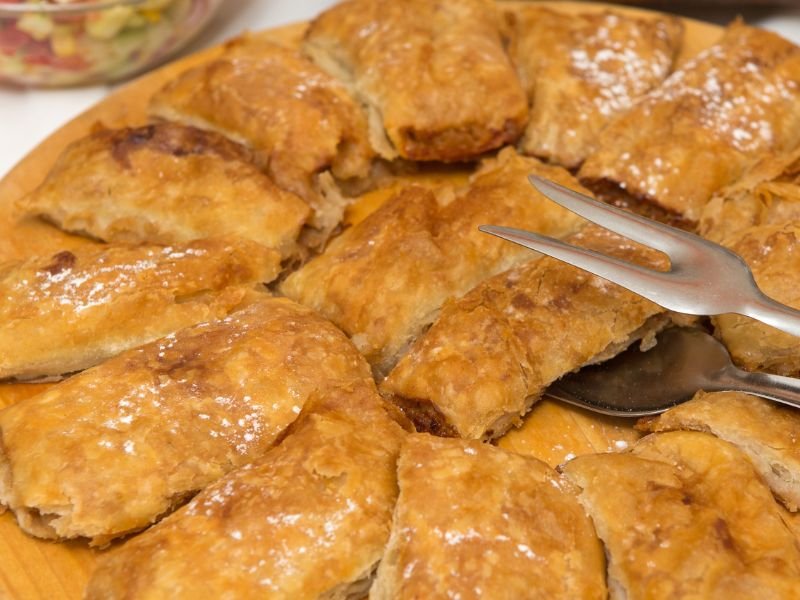
2) Štrukle
Another specialty served mostly in northwestern Croatia is Štrukle, made from very thinly rolled out pastry, over which a mixture of tangy cottage cheese, eggs, and sour cream is spread before the pastry is rolled and cut into 10cm-long pillows. Štrukle are then boiled or baked covered with sour cream sand salt. At first glance you may think Štrukle is a sweet pastry, but as you take a bite and the gooey cream and cheese centre runs down your chin, you’ll discover it’s actually a savoury treat. Good luck stopping at just one.
The famous vacation cities of Split and Dubrovnik are located on the coastal part of Croatia known as Dalmatia. It’s along the Dalmatian coast where fisherman haul in tonnes of the finest Mediterranean fish, scampi, mussels, and squid, and pass it along to Dalmatian chefs who will serve your lunch using just two or three ingredients – and always have you drooling.
- Savory or Sweet: One of the things that make Štrukle so special is its versatility. The classic savory version is filled with fresh cow’s cheese, sometimes with the addition of herbs or even spinach, and is usually served with a dollop of sour cream on top. However, there’s also a sweet version, where the filling is enriched with sugar, vanilla, or sometimes even fruit. This dual nature of Štrukle means it can be enjoyed as a hearty main course or a delightful dessert.
- Baked or Boiled: The preparation method also adds to the variety. Baked Štrukle is typically made in a casserole dish and covered with a layer of sour cream or melted butter before being baked to golden perfection. The result is a warm, comforting dish with a slightly crispy top and a creamy, rich filling. Boiled Štrukle, on the other hand, is cooked in boiling water or broth, resulting in a softer texture and a more delicate flavor. Both versions have their own unique appeal, and trying both is highly recommended to fully appreciate this Croatian delicacy.

3) Pašticada
One exception to the less-is-more ingredient rule in Dalmatia is Pašticada, which is a hearty beef dish, traditionally made in Dalmatia. This dish takes over 24 hours to prepare. So, is often reserved for special occasions or eaten out. Numerous variants of the dish exist and no chef will ever really give away all of their winning pašticada secrets. In all recipes, the meat is pierced and stuffed with aromatic garlic, onions and bacon, and left overnight in mixture of red wine and water. The oh-so-tender beef is then fried on all sides in olive oil and cooked in a sauce for at least 3 hours. Unusually for Dalmatian cooking, this dish is made up of different spices such as nutmeg, cloves, and dried fruit, producing a rich velvety sauce that you can mop up with fluffy homemade bread.
- The Preparation: The process of making Pašticada is a labor of love that starts long before the cooking even begins. The beef, traditionally a cut of the round, is marinated for hours—sometimes overnight—in a mixture of vinegar, garlic, and spices. This marination not only tenderizes the meat but also infuses it with a depth of flavor that’s crucial to the dish. After marinating, the beef is browned and then slow-cooked in a rich sauce made from onions, carrots, prunes, wine, and a variety of herbs and spices. The result is a tender, melt-in-your-mouth dish that’s bursting with complex, savory, and slightly sweet flavors.
- The Sauce: The sauce is the heart of Pašticada, carefully balanced with sweet and tangy notes that complement the richness of the beef. Ingredients like dried fruit, wine, and vinegar are simmered together, creating a sauce that’s thick, velvety, and deeply flavorful. As the beef cooks slowly in this sauce, it absorbs all the flavors, resulting in a dish that’s both hearty and elegant.
- Serving Tradition: Pašticada is traditionally served with homemade gnocchi, which perfectly soak up the rich sauce. The pillowy gnocchi and the succulent beef make for a combination that’s both comforting and sophisticated. In some regions, it’s also served with pasta or potatoes, but gnocchi remains the classic accompaniment.

4) Crni Rižoto
Don’t even think about picking up your backpack and leaving Dalmatia without trying the most unique risotto you’ll ever find. Thanks to the Italian food influences in Croatia, a good risotto can be found on every menu. Look out for Crni rižoto, which is made with diced cuttlefish. This risotto is the unusual colour of pitch black, dyed by the ink within the cuttlefish pouch, which gives the dish an intense fish flavour. Just be sure not to drop any on your favourite outfit, that stain may never wash out! If you can look past the colour, you’ll no doubt delight in this truly unique-tasting dish.
- Ingredients and Preparation: The base of Crni Rižoto is typically made with Arborio or Carnaroli rice, known for their creamy texture when cooked. The dish starts with sautéed onions and garlic, to which diced cuttlefish or squid is added. The seafood is cooked until tender, then simmered with white wine, fish stock, and the all-important ink, which gives the risotto its signature black hue. The ink not only provides color but also infuses the dish with a deep, briny flavor that perfectly complements the seafood. A touch of Parmesan cheese and a squeeze of lemon juice are often added at the end, enhancing the dish’s creamy texture and adding a bright note of acidity.
- A Feast for the Senses: Crni Rižoto is a feast for both the eyes and the palate. The rich black color is striking and unusual, immediately catching your attention and setting the stage for a bold and flavorful dining experience. The taste is equally distinctive, with the savory umami of the seafood and the subtle earthiness of the ink coming together in perfect harmony. It’s a dish that’s as complex as it is satisfying, with each bite offering layers of flavor that reflect the freshness of the Adriatic Sea.
5) Slavonski Kulin
One of the least known parts of Croatia for tourists is Slavonia. However, it is known to all Croatians as it is specially revered for the Slavonski kulin. Often shortened to kulen, this is a type of heavily spiced large sausage made from ground pork from enormous black pigs. Along with garlic, heaps of paprika is added to give it both the taste and the distinct red colour. The meat is piped into bags made from pork intestine, giving it a very recognisable shape. Once it is smoked and dried for at least several months, it is then ready to be devoured with cheese and red wine.
- Artisanal Preparation: What makes Slavonski Kulin truly special is the traditional, artisanal method of preparation. The process begins with selecting the best cuts of pork, typically from free-range pigs raised in the Slavonian countryside. The meat is carefully minced and mixed with a blend of spices, with paprika being the star ingredient. This mixture is then stuffed into natural casings, which are tied off and left to dry-cure in a smokehouse. The curing process can take several months, during which the sausage develops its rich, smoky flavor and firm texture.
- Distinctive Flavor Profile: The flavor of Slavonski Kulin is robust and full-bodied, with a delightful balance of smokiness, spiciness, and savory richness. The paprika gives it a deep red color and a slightly spicy kick, while the garlic and other spices add layers of complexity. The long curing process allows the flavors to meld together, resulting in a sausage that’s both intense and nuanced. Each bite is a burst of flavor, with the smokiness lingering on the palate long after you’ve finished.
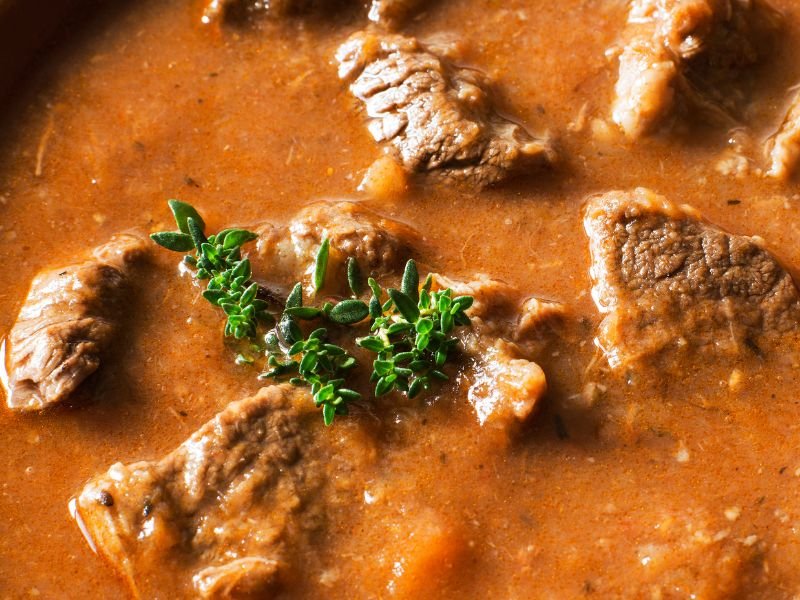
6) Čobanac Goulash
Plan your trip to Slavonia for the Čobanac festival. This annual event is centred around a competition to cook a soupy stew in oversized bronze pots on an open fire. The Čobanac goulash from which the festival name derives is made from three types of meat; usually pork, beef, and a type of game or horse-meat, which is seasoned with handfuls of hot paprika to give it a real kick.
With the extremely fertile land in Slavonia, Croatia’s proximity to the sea in Dalmatia, as well as the result of thousands of years of foreign occupation, there are many influences which make up Croatian cuisine. No matter where you are, Croatians are extremely proud of their gastronomic traditions and they will each tell you that their family recipe is the best. In a way, they’re all right.
- Hearty Ingredients: Čobanac is typically made with a mix of different meats, such as beef, pork, and sometimes even game like venison. The meat is slow-cooked with onions, garlic, and a generous amount of paprika, which gives the stew its deep red color and warm, spicy flavor. Other ingredients might include tomatoes, peppers, and bay leaves, all simmered together until the meat is incredibly tender and the flavors are well combined. The result is a rich, robust stew that’s packed with savory goodness.
- Slow-Cooked Tradition: The key to Čobanac lies in its slow cooking process. Traditionally, it’s cooked over an open fire in a large pot, often taking several hours to prepare. This slow cooking allows the flavors to meld together, creating a deeply satisfying dish that’s both flavorful and comforting. The long simmering time also ensures that the meat is tender and infused with the smoky, spicy notes of the paprika and other spices.
How to Turn These Dishes into a Food-Focused Croatia Trip
Reading about Kremšnite, Pašticada, and Crni Rižoto is one thing. Actually sitting at a crowded konoba table with a carafe of house wine, a plate of something slow-cooked, and the sea a few steps away is another.
The nice thing about Croatian food is that it’s incredibly regional, but not hard to track down if you’re even a little bit intentional. With a bit of planning, you can turn your Croatia trip into an easy-going food crawl that moves from pastry and cheese in the north, to seafood and risotto on the coast, and hearty stews and sausages in Slavonia.
Think of it as three broad “food zones”:
- Zagreb & northern Croatia – kremšnite, štrukle, hearty comfort food, cakes, and coffee culture.
- Dalmatian coast & islands – grilled fish, Pašticada, Crni Rižoto, olive oil, and wine by the sea.
- Slavonia & the east – Slavonski kulin, Čobanac, spicy stews, and big meat-heavy spreads.
Once you start seeing the country that way, it gets much easier to decide where to base yourself, how long to stay, and what to hunt down first with a fork in hand.
Where to Eat Croatia’s Classic Dishes by Region
Zagreb & Northern Croatia: Pastry, Štrukle and Café Culture
If you’re flying into Zagreb, you’re already in prime territory for kremšnite and štrukle. This is where afternoons somehow turn into cake-and-coffee marathons.
What to Look For in Zagreb
You don’t need fancy addresses; you’re looking for classic city cafés and old-school pastry shops around the main square and the historic Upper Town:
- For Kremšnite
- Follow the locals to cafés where you see tall, square, wobbly cream cakes chilling in the display case.
- Order a slice, sit down properly, and pair it with a strong coffee. This isn’t a grab-and-go dessert; it’s a full event.
- For Štrukle
- Look for places that specifically list Zagorski štrukli or štrukle zapečene (baked štrukle) on the menu.
- You’ll usually get a bubbling dish that looks like lasagna’s Croatian cousin: baked, slightly browned on top, creamy and cheesy inside.
- Beyond the Big Two
Once you’ve ticked kremšnite and štrukle off the list, there’s more northern comfort food worth hunting down:- Goulash-style stews with dumplings or mashed potatoes.
- Roast meats with potatoes and seasonal vegetables.
- Yeasted cakes and nut rolls (like orehnjača) in family-style restaurants and bakeries.
If you’ve got time for a half-day trip from Zagreb, nearby small towns and villages will introduce you to rural “agrotourism” spots where lunch might include house-made cheese, cured meats, and home-baked bread served at a farmhouse table.
Dalmatian Coast: Seafood, Pašticada, and Crni Rižoto
Move down to the coast and the menu changes completely. Now you’re in Pašticada and Crni Rižoto territory, with seafood staring back at you from the grill.
Split, Dubrovnik, and the Islands
On the Dalmatian coast, the magic words you’re looking for are “konoba” (traditional tavern) and “marenda” (local-style lunch).
- Konobas
- Usually family-run, often with a short menu, and heavy on whatever came off the boat that morning.
- Great places to order:
- Crni rižoto (black risotto)
- Grilled fish (ask for the daily catch)
- Simple plates of mussels or clams in white wine and garlic
- Slow-cooked Pašticada with gnocchi
- Marenda
- A late-morning / early-afternoon “workers’ lunch” special: cheap, filling, and very local.
- Expect dishes like stewed beans, simple fish, or meat in sauce, served with bread and maybe a small salad.
In Split, look around the old town and just outside the tightest tourist circle; one or two streets away from the most obvious squares is where prices calm down and menus get more local.
In Dubrovnik, it pays to walk away from the main street inside the walls and out towards quieter neighbourhoods or the Lapad area. The food gets more honest and the bill hurts less.
On the islands (Hvar, Brač, Korčula, Vis), you’ll come across:
- Peka – meat or octopus slow-cooked under a metal bell with potatoes and vegetables.
- Gregada or brodet – fish stews with simple, rich broth.
- House olive oil and wine – often made by the family running the place.
It’s not unusual to find Pašticada listed as a special a couple of times a week, especially on Sundays or for events. If you see it on the chalkboard and you’re a meat lover, that’s a good day to sit down and commit.
Slavonia & the East: Sausage, Stews, and Big Plates
Head east, towards Osijek and the flatlands of Slavonia, and the mood changes again. Here it’s all about meat, paprika, and full tables.
This is where Slavonski kulin and Čobanac goulash really belong.
- Slavonski kulin
- Often served sliced as a starter, alongside cheeses, pickles, and bread.
- Ask for a “plata” or mixed board, and you’ll usually get a bit of everything: kulin, other cured meats, maybe some lard spread, and local cheese.
- Čobanac
- Hearty, spicy stew served in deep bowls with bread or sometimes pasta/potatoes on the side.
- Don’t expect a small portion; this is working-farmer food.
Slavonian restaurants and countryside guesthouses usually do generous set menus where kulin, stews, roasts, and cakes follow one another in a slow parade. Come hungry and don’t plan anything too ambitious afterwards.
Everyday Food: Bakeries, Street Bites, and Markets
You don’t need a reservation to eat well in Croatia. Some of the best “I could live here” moments happen standing at a counter or walking down a street with something flaky in your hand.
Bakeries (Pekara) and Quick Bites
The humble pekara is your best friend, especially if you’re trying to keep a lid on the budget while still tasting the country.
Typical things to grab:
- Burek – spiral or rectangular pastry stuffed with cheese, meat, spinach, or a combo.
- Pizza slices – not unique to Croatia, but easy and filling.
- Sweet pastries – jam-filled, chocolate-filled, or just sugar-dusted.
A simple breakfast or late-night snack from a bakery might cost less than a coffee in many Western European cities, and you’ll see locals grabbing these on the go all day long.
Markets
Most bigger towns have some version of a green market in or near the centre. If you’re self-catering or just curious, it’s worth going early:
- Piles of seasonal fruit and vegetables.
- Stalls selling homemade olive oil, honey, jams, and rakija (fruit brandy).
- Butchers and fishmongers, especially along the coast.
Even if you’re not cooking, you can assemble an easy picnic: bread, cheese, cured meat, some tomatoes or figs, and a bottle of something local. Eat it on a bench overlooking the sea or in a park and you’ve got yourself a five-star lunch for the price of a takeaway coffee back home.
What It Costs to Eat Well in Croatia
Prices vary between Dubrovnik in peak season and a small inland town in October, but these rough ranges give you a pretty good sense of what to budget per person:
Typical Food & Drink Costs (Approximate)
| Meal / Item | Budget Local Option | Midrange Sit-Down | Splurge / Special Night |
|---|---|---|---|
| Breakfast (bakery + coffee) | 4–6 € | 8–12 € (café with hot dish) | 15+ € (hotel brunch) |
| Light lunch (snack or sandwich) | 5–8 € | 10–15 € | 20+ € |
| Main dish at konoba/restaurant | 10–14 € (pasta, simple grill) | 15–25 € (fish, Pašticada) | 30–40+ € (top seafood / tasting) |
| Glass of house wine | 3–5 € | 4–7 € | 8–10+ € |
| Draft beer | 3–5 € | 4–6 € | 7–8+ € |
| Dessert in a café | 3–6 € | 6–8 € (big slice or fancy) | 10+ € (hotel / view tax) |
If you’re careful with where you eat and lean on bakeries and markets, a daily food budget of 25–35 € per person is manageable. If you like a restaurant lunch and dinner plus drinks, 40–60 € per day is more realistic on the coast in high season.
Best Time of Year for Food Lovers
You can eat well in Croatia year-round, but certain seasons really shine from a food perspective.
Spring (April–May)
- Fresh greens, wild asparagus, early strawberries.
- Fewer crowds on the coast, easier restaurant reservations.
- Nice shoulder-season sweet spot if you want to combine food with some light hiking or cycling.
Summer (June–August)
- Peak seafood season along the coast: grilled fish, Crni Rižoto, cold white wine in the heat.
- Nightlife is in full swing, with late dinners and crowded terraces.
- Prices are highest and the most touristy spots can get very busy, so it’s worth booking popular restaurants a day or two ahead.
Autumn (September–October)
- Harvest season: grapes, figs, chestnuts, mushrooms, and hearty stews returning to menus.
- Coastal water is still warm, but the energy is calmer and tables are easier to get.
- Great time to head inland to Slavonia or northern wine regions for big meals and tastings.
Winter (November–March)
- Quieter on the coast, some tourist-oriented places may close or reduce hours.
- In cities and inland, this is proper comfort food season: goulashes, roasts, and long, lazy meals.
- Christmas markets in cities like Zagreb bring extra street food options and hot drinks.
Sample Foodie Itineraries in Croatia
3-Day Dalmatian Coast Taster (Split-Based)
Day 1 – Split Old Town & Riva
- Morning: Coffee and a pastry on the seafront promenade.
- Late morning: Explore Diocletian’s Palace, then grab a simple marenda at a konoba (beans, stewed meat, or grilled fish).
- Evening: Go all in on Pašticada with gnocchi and a carafe of red wine at a traditional tavern.
Day 2 – Island Escape + Seafood
- Morning: Hop on a boat to a nearby island (Brač or Šolta work well).
- Lunch: Seaside konoba for grilled fish, squid, or Crni Rižoto.
- Afternoon: Swim, wander, nap in the shade.
- Evening: Back in Split, gelato and a stroll along the Riva.
Day 3 – Markets and Local Snacks
- Morning: Visit the green market and fish market, snack on fresh fruit and bakery treats.
- Lunch: Aim for a proper seafood lunch: mussels, risotto, salad.
- Evening: Casual dinner of pizza, burek, or ćevapi if you need a break from fish, followed by a dessert and coffee.
7-Day Croatia Food Loop (Zagreb – Coast – Inland)
Day 1 – Zagreb
- Arrive, drop bags, head straight to a café for Kremšnite and coffee.
- Dinner: Štrukle and a hearty main at a traditional restaurant.
Day 2 – Zagreb & Surroundings
- Slow morning with another café session and people-watching.
- Optional side trip to a nearby small town or village restaurant for a long lunch with roast meats and local wine.
Day 3 – Travel to the Coast
- Make your way towards the Dalmatian coast (Split or Zadar).
- Dinner: First coastal meal – grilled fish, salad, house white wine.
Day 4 – Split or Zadar Food Day
- Breakfast at a bakery, then market wandering.
- Lunch: Crni Rižoto or a fish stew.
- Dinner: Pašticada or another slow-cooked meat dish at a konoba.
Day 5 – Island or Coastal Day Trip
- Boat trip or coastal drive.
- Long, lazy lunch at a small family-run konoba, focusing on whatever the daily catch is.
Day 6 – Head Inland to Slavonia (or Another Inland Region)
- Travel towards the east (Osijek / Slavonia) or choose another inland region if that fits your route better.
- Dinner: Mixed platter with Slavonski kulin, cheese, and rustic bread.
Day 7 – Slavonia Feast & Departure
- Lunch: Čobanac goulash or another paprika-heavy stew, followed by dessert and strong coffee.
- Roll yourself towards the train station or airport with zero regrets.
You can tweak the order or substitute Istria, Kvarner, or another inland region, but the basic rhythm – north pastries → coast seafood → eastern meats – works beautifully.
Croatia Food Guide FAQ: Essential Questions, Local Tips & Tasty Answers
What are the must-try traditional Croatian dishes on a first trip?
Honestly, you could spend a whole trip just eating, but if it’s your first time I’d prioritise kremšnite (cream slice dessert), štrukle (baked cheese-filled pastry), pašticada with gnocchi (slow-braised beef), crni rižoto (black cuttlefish risotto), Slavonski kulin (paprika-heavy cured sausage) and čobanac goulash (spicy meat stew). Add in a few everyday staples like burek from a bakery, grilled Adriatic fish on the coast, and at least one peka (meat or octopus slow-cooked under a metal bell) and you’ve basically eaten your way through a crash-course in Croatian cuisine.
Which regions of Croatia are best if I want to plan a food-focused itinerary?
Absolutely. For a food-focused route I like to think in three zones: Zagreb and northern Croatia for kremšnite, štrukle and café culture; the Dalmatian coast and islands for seafood, pašticada, crni rižoto and peka; and Slavonia in the east for kulin, čobanac and big paprika-heavy stews. You can build a neat loop that goes Zagreb → coast (Split or Zadar plus an island) → Slavonia or a wine region, and taste completely different styles of cooking in each place.
How many days do I need in Croatia if I really want to enjoy the food properly?
It depends. If you just want a taste, you can weave food into a classic 7-day coastal trip, but 10–14 days gives you time to slow down, eat long lunches and try all three major food regions. A nice balance for many travellers is 2–3 days in Zagreb, 3–4 days on the Dalmatian coast, and 2–3 days inland (Slavonia or a wine region), with at least one market morning, one proper konoba feast and one simple picnic in each stop.
Is Croatian food expensive compared to other European countries?
Not really. Croatia has crept up in price on the coast in July and August, but eating well still costs less than in places like Italy or France if you avoid the most touristy streets. Roughly speaking, you can get by on 25–35 € per person per day if you lean on bakeries, markets and simple konobas, while 40–60 € per day lets you have a sit-down lunch and dinner with drinks in coastal cities during high season.
When is the best time of year to visit Croatia if my main goal is food?
Autumn and late spring are hard to beat if you’re travelling for food. April–May brings greens, strawberries and fewer crowds, while September–October is harvest season with figs, grapes, mushrooms and hearty stews reappearing on menus, plus warm sea water and calmer terraces on the coast. Summer is fantastic for seafood and buzzy outdoor dinners but you’ll pay more and need to book popular spots, and winter turns things into full comfort-food mode in the cities and inland.
Can vegetarians or vegans eat well in Croatia, or is it all meat and seafood?
Yes. Croatia is still very meat- and fish-forward, but vegetarians will be fine in most cities and popular coastal towns, especially in Zagreb, Split, Zadar, Rijeka and Dubrovnik where veggie mains, salads and pasta dishes are easy to find. Vegans need to be a bit more intentional, but you’ll still find dedicated spots and clearly labelled options in bigger centres, and you can always fall back on things like vegetable risottos, grilled veggies, salads, bread, olives and bakery items; smaller inland towns just require a bit more flexibility.
How easy is it to find gluten-free or allergy-friendly options in Croatian restaurants?
It depends. In larger cities and touristy coastal areas, many menus now mark gluten-free dishes and staff are used to questions about nuts, dairy or shellfish, especially in places that see lots of international visitors. In smaller local taverns and rural areas, you’ll want to keep it simple, explain your needs clearly and maybe learn a couple of key phrases or show them written down, and if your allergy is severe it’s smart to carry translation cards and stick to dishes that are naturally safe for you.
What’s the difference between a konoba, restoran, bistro and pekara in Croatia?
A konoba is a traditional tavern, usually family-run, with a short menu of local dishes and house wine; this is where you hunt down pašticada, crni rižoto, peka and simple grilled fish. A restoran is a broader, sometimes more formal restaurant that might mix Croatian and international dishes, while a bistro tends to be casual, modern and often a bit creative with the menu. A pekara is a bakery, your best friend for burek, pastries and cheap breakfasts or snacks on the go.
Do I need to make restaurant reservations in Croatia, especially in Dubrovnik and Split?
Yes. In July and August, and on weekends in popular places like Dubrovnik, Split, Hvar or Rovinj, it’s smart to reserve at least a day ahead for well-known konobas and any place you’re really excited about. Outside peak season, you can often just wander and sit down, but I still like to book for Friday and Saturday nights or if I’ve got my heart set on somewhere small and local with limited tables.
Is it customary to tip in Croatian restaurants, and how much is normal?
Absolutely. Service is sometimes included, but it’s still common to round up or leave a small tip if you’re happy with the meal. In casual places and bakeries you can just round up the bill or leave an extra euro or two, while in sit-down restaurants 5–10% is appreciated and 10–15% is generous for really great service, especially in busy coastal cities during high season.
Is tap water safe to drink in Croatia, or should I stick to bottled water with meals?
Yes. Tap water is generally safe to drink throughout Croatia, and locals drink it at home without thinking about it, so you can refill a bottle and skip buying endless plastic. Restaurants may default to offering bottled still or sparkling water, but you can politely ask for tap water, and I like to carry a reusable bottle for market days, hikes and long city walks between cafés and konobas.
Is Croatian food and restaurant culture family-friendly for kids?
Absolutely. Croatian restaurant culture is very family-oriented, and you’ll see kids at konobas, pizzerias and cafés late into the evening in summer, especially along the coast. Menus usually have safe options like grilled meats, pasta, fries, simple fish and pizzas, and staff are generally patient with restless little ones; just keep in mind that dinners tend to run later, so an early bakery snack or small picnic can help bridge the gap if your kids are used to earlier meals.
Are there any food-related scams or tourist traps I should watch out for in Croatia?
Not really. Croatia is generally straightforward when it comes to food, but in the most touristy old towns you’ll see a few places with high prices and mediocre quality banking on the view. A good rule of thumb is to step a street or two away from the main squares, check whether prices are clearly listed, and glance at what locals are eating; I also avoid places where someone is aggressively trying to pull me in from the door and head for the small konoba that looks busy with Croatian families instead.
What should I expect from portion sizes, and is it normal to share plates in Croatia?
Big. Portions in Croatia are often hearty, especially in Slavonia and at traditional konobas where plates are built around farmers and fishermen appetites, not dainty tasting menus. It’s completely normal to share a couple of mains, a salad and some sides between two or three people, and if you’re not sure how much to order you can just say you’d like to share and ask the server whether one portion is enough for two.
Can I join food tours or cooking classes in Croatia to learn more about local dishes?
Yes. In cities like Zagreb, Split, Dubrovnik, Zadar and Rovinj you’ll find walking food tours that combine markets, bakeries and konobas, as well as small-group cooking classes where you might learn how to make dishes like štrukle, pašticada or peka. I like to book one early in a trip because you pick up menu vocabulary, ordering confidence and local recommendations you can then use for the rest of your time in Croatia.
What should I pack or plan for if I want to do picnics and self-catering in Croatia?
I’d pack a lightweight reusable shopping bag, a small knife with a protective cover, a refillable water bottle and maybe a plastic or bamboo container for leftovers or picnic spreads. Markets and supermarkets make it easy to assemble bread, cheese, cured meats, fruit and wine, and most apartment stays come with at least a basic kitchen, so you can cook simple meals with local ingredients and save your restaurant budget for those long konoba lunches by the sea.
Practical Food Tips and Mistakes to Avoid
A few small tweaks in how you eat and where you sit can completely change your experience.
Simple Tips
- Look for daily specials – chalkboards, handwritten menus, or a small “today’s dish” section usually mean seasonal, local, and good value.
- Ask for house wine – in many konobas, the house red or white is local, cheap, and perfectly drinkable.
- Share dishes – portions can be large. Sharing two mains and a few sides is very normal and lets you try more.
- Follow the locals’ schedule – big lunches, slightly later dinners. If a place is packed with Croatian families on a Sunday, that’s the best endorsement you’ll ever get.
Common Mistakes
- Eating only on the most touristy streets
- A short walk around the corner often drops the prices and increases the quality.
- Not reserving during peak season
- In July and August on the coast, popular konobas fill up fast. A quick phone call or in-person reservation earlier in the day saves you from disappointment.
- Sticking only to “safe” dishes
- It’s easy to default to pizza and pasta, but Croatia rewards curiosity. Crni Rižoto might look intimidating, but it’s usually the dish people talk about years later.
- Ignoring inland regions
- The coast gets all the glossy photos, but some of the heartiest, most memorable meals happen far from the sea, at a wooden table, with a pot of stew and a jug of wine.
Eat slowly, say yes to the dish you can’t pronounce, and leave a little room after every meal—you never know when another slice of kremšnite or a plate of kulin will appear in front of you.
BIO
SJ Begonja: SJ is an Australian expat who lives in a small Croatian village & writes about Croatian food, travel & her experiences as making Croatia home with her family.
Chasing the Donkey – A local’s guide to Croatia. The best of food, travel and culture.
Google+ (http://www.chasingthedonkey.com/a-locals-guide-to-travel-croatia/)
Facebook (https://www.facebook.com/chasingthedonkey)
Twitter (https://x.com/chaseTHEdonkey)
Instagram (http://instagram.com/chasingthedonkeycroatia)
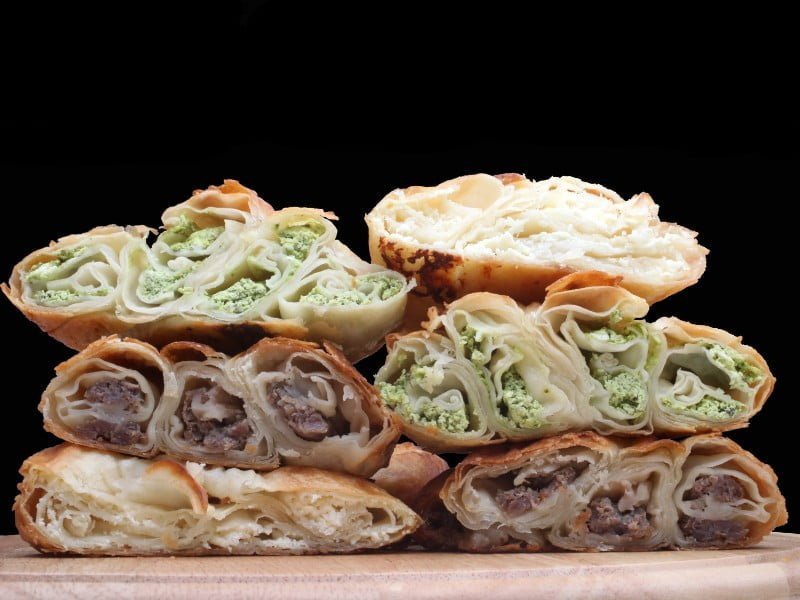

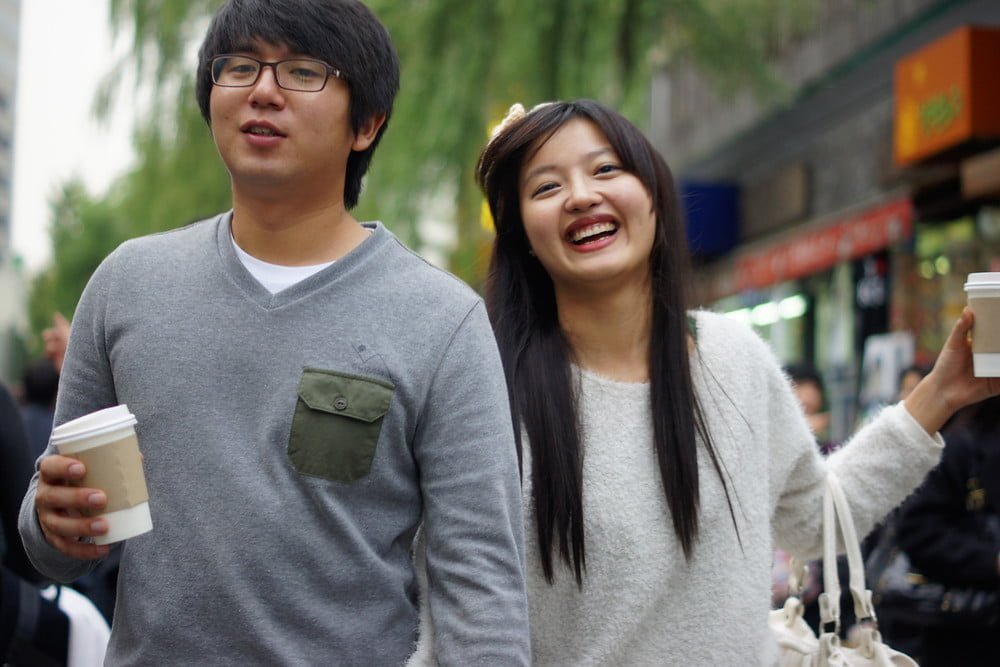

I can suggest a lamb meat and sheep cheese from Island of Pag. Lamb has specific flavor because of the environment in which lives and feeds autochthonous Pag sheep Pramenka. A variety of medicinal plants grows on the karst, barren rocks: sage, nightingale, miserly, small grass strewed with salty wind, from frequent winter storm. A world gastronomes consider it to be unforgettable delicacy of Pag table.
My friend and I are going to visit Croatia at the end of the August. I have a small hope that Italians put their influence not only on the risotto but on the ice cream too.
vanilla and egg custard cream cake sounds so tasty. I intend to make it at home. I am a sucker for cakes.
Wow the Crni rižoto looks like something out of a Dr Seuss! Great post, it’s making me hungry!
Mm look forward to visiting Croatia sometime and trying these dishes!
Between one of the 6 traditional dishes, wich i ‘ll prefer to taste is a dishes of fish, if the chance permit me to visit this beautiful country.
SJ and Samuel, As you know food is life! And Croatian food is heaven! Love this post!
Food in Coratia is really specific. I love how they make sea food. Cheers.
Njam! The food looks delicious! Have you tried the Croatian cheese?
Cool insights on Croatian food! I am happy to know that there is touch of Italian gastronomy too – you get to eat excellent Risotto in Croatia. And I am even happier to know about the confectioneries for my sweet tooth! 🙂
Good read! I’ve been to Croatia twice now over the past few years and was really impressed with the food. But don’t think I tried all this. Which basically means I will have to go back soon.
Looks like I missed a few delicious things when I went to Croatia — just an excuse to return! Thanks for sharing and for making my mouth water 🙂
Very nice list! I liked this list very much. Wishes for a beautiful European Christmas and a Happy
New Year to you! 🙂
Fascinating food suggestions in this post. The Slavonski kulin seems very similar to the Portuguese pork sausages. Even though I have a sweet tooth I think the pastries would be slightly too-over-the-place for my taste though 🙂
Is that an Octopus?
Great foodie inspired post – I love Croatia – have only spent a week in Zagreb couch surfing but tried the kremšnite and it was so yummy – can’t wait to go back
Laura x
Hmmm, I am hungry. I think I’ll go and get me some Kulen and bread. Thanks for letting us share our thoughts with your readers.
Thanks SJ! You’ve made us all hungry as well. What delicious food to try in Croatia 🙂
I’m glad I saw this article. We spent a few days in Zagreb, had a rough time finding any restaurants let alone Croatian cuisine-specific ones. I guess next time we’ll need to try the coast for the food.
That’s awesome Kalli. I hope you find some great Croatian food the next time you visit.
Across Croatia it’s hard to weed the tourist traps from the good places. I have a few suggestions for Zagreb and the coast, so if you come back – ask me and you won’t be hungry:)